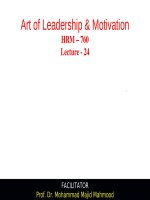Lecture Essay writing & presentation skills - Lecture 24: Dos & Don’ts
Bạn đang xem bản rút gọn của tài liệu. Xem và tải ngay bản đầy đủ của tài liệu tại đây (1.06 MB, 45 trang )
Lecture
24
DOS & DON’TS
Presentation Skills
Your best is to
remember the
following…
Dos & Don’ts
DO’S & DON’TS
•
Clean & Simple Slides
Ø
Keeping 1/3rd of a slide clear is a good
idea
•
Effective Content
•
Format appropriately
•
Title & Text placements are
3
DON’T
•
Choose Serif fonts like Times New Roman
•
They are harder to read on a screen
For Instance:
Business communication is different from other types of
communication. It always needs to be clear and concise,
and most of the time it needs to be fast. But fast or slow,
when you give a speech or presentation, or send an email or
memo, remember that you’re giving them information, but
you also want them to do something with it.
Do
•
•
Use san-serif fonts like:
–
Ariel
–
Gil Sans, or
–
Century Gothic
They are easier on the eye
Example:
•
Ariel
Business communication is different from
other types of communication. It always
needs to be clear and concise, and most of
the time it needs to be fast. But fast or slow,
when you give a speech or presentation, or
send an email or memo, remember that
you’re giving them information, but you also
want them to do something with it.
DON’T
•
Underline words for emphasis
–
People mistake these for hyperlinks and they
are harder to read.
DO
•
Vary a font’s
size
•
style or
•
color for emphasis or
•
group words together
*But avoid doing it all on one slide
DON’T
Use visually complex
fonts
Especially a variety of
them
DO
Choose easy to read fonts
&
Stay in a font family
DON’T
Use fonts that are smaller than 24
points
Any smaller and it can’t be read easily from a distance
Text Tips
•
Text slides should be brief:
1.
No more than eight words per line
2.
No more than eight lines per slide
3.
Fewer words will force an
explanation rather than reading slide
word for word
12
Font Analysis
•
Font and Transition
•
If you use small font your audience wont be able to read from the slide
•
CAPITALIZE ONLY WHEN NECESSARY.
IT IS DIFFICULT TO READ.
•
Don’t use complicated/ distracting transitions.
•
Don’t use a complicated font. Stick to
sans serif fonts (without twiddles)
13 like arial.
Text Tips
•
Titles should be 36-40 point
Title (40 points)
•
Body text should be at least 24
points
She sells seashells
She sells seashells
Body Text (24 points)
Sans Serif font
Serif font
•
14
Use sans serif font such as Arial
DO
Back up about 2 feet Watch your
presentation
See if you can read everything
DO
•
Choose a color palette & layout style
•
And stick with it
DON’T
Fill up the screen with lots and lots
information written in sentence form. Or
even bullet after bullet after bullet. The
visuals in your presentation should help
guide your speaking, not replace it. People
can read faster than they can speak, and
they don’t want to hear you just read from
the slides. Plus, the more you put on a slide,
the smaller the text will get and the smaller
the text gets, the harder it is to read. Then,
Too much Text
•
This page contains too many
words for a presentation slide. It is
not written in point form, making it
difficult both for your audience to
read and for you to present each
point. In short, your audience will
spend too much time trying to
read this paragraph instead of
listening to you. Eventually it will
make your slide wordy and boring.
19
•
aaaaaaaa…. First slide.
20
DO
Choose only key points to highlight Follow
a
7 words / 6 lines guideline
Make every slide matter
DON’T
Go crazy with sound effects and
animations*
*Imagine many things spinning
& whizzing around on the page
DO
Change the pace by adding
Relevant video and website
links*
*Just make sure you’ve loaded









